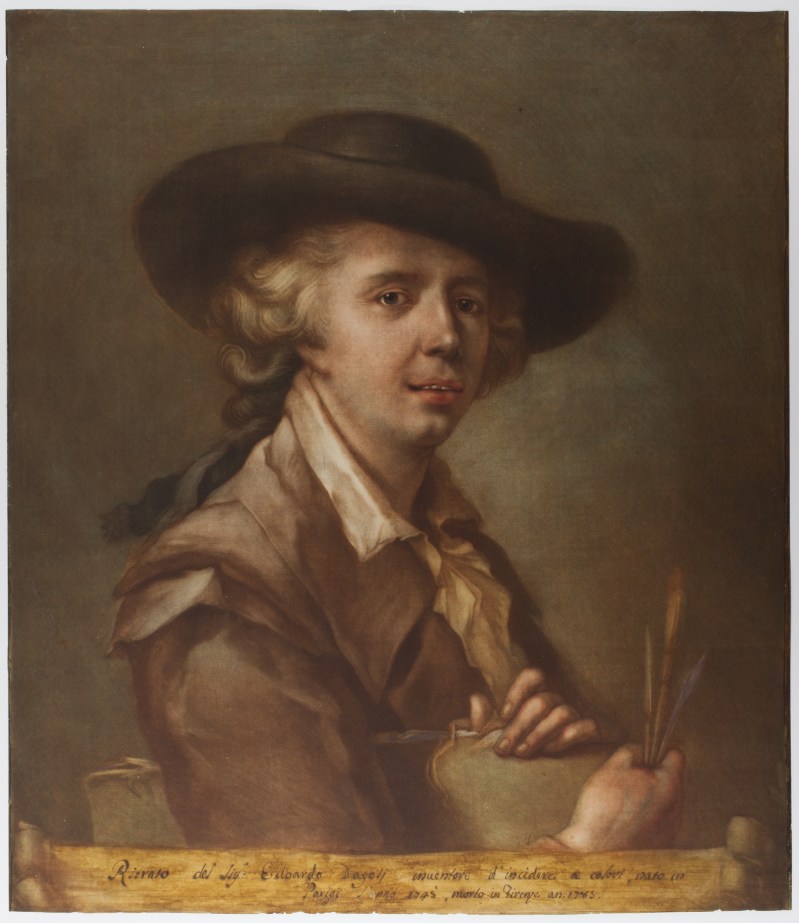Carlo LASINIO (1759 - 1838): Portrait of Edouard Dagoty, inventor of color print - c. 1784
Price: 18 000€
Colour mezzotint printed from four plates, 502 x 435 mm (sheet). Nagler 3, Le Blanc 149, Singer 444.
Very rare impression, without any printed letter, a title added in Italian in pen and ink: Ritrato del Sige : Edoardo Dagoti inventore d'incidere a colori, nato in Parigi l'anno 1745, morto in Firenze an: 1783. It is possible that the letter has not yet been engraved, unless it has not been printed on our impression. The engraved letter found on most impressions (see, for example, the Rijksmuseum impression) is in French: Portrait d'Edouard Dagoty inventeur de la gravure en cōleurs / neè a Paris l'An 1745. mort a Florēce l'8. Maj 1783 / Pent par Kanchsius Gravé, et desinee par de Lasinio Imprime par Labrelis. Nr. 4. Some impressions do not include the number (see, for example, the National Gallery of Art impression). The caption on our impression specifies the subject of the print, without mentioning the authors or the printer. Hans Singer reports another impression with a handwritten inscription in Italian: Odoardo Dagoty / Inventore d'incidere a Colori / pintosto migliatori, poiche l'invenzione / e dovuta a Giac° Le Blond / In Parigi nato 1745 Morto 1784 in Milano. While the place and date of Gautier d'Agoty's death are erroneous here, the attribution to Le Blond of the invention of the black manner in colour is entirely accurate.
Superb impression printed in colours (dark brown, light brown, blue-green and red), with a few rare gouache highlights (as is often the case) on watermarked laid paper (watermark: GORI LIVINI e COMPAGNI). Trimmed to the platemark, as is often the case with this print. Very good condition. Very tiny losses of paper at top and bottom edges; some abrasions and foxing on verso.
Most impressions of this rare portrait are enhanced with gouache. Some are almost entirely overpainted, which distorts the colour mezzotint. This is the case, for example, of this impression sold on April 29, 2021 at Drouot, or of this impression in the British Museum. Our impression, on the other hand, contains only a few light hints of gouache: a small touch of violet on one of the brushes and on the edge of the drawing board, a small hint of white on the teeth and in the eyes. The rest of the impression is the product of hundreds of tiny dots of colour mezzotint.
Provenance:
- Louise Balthy (1867-1925), café-concert performer during the Belle Époque. This print was sold at auction in 1917 at the Galerie Georges Petit; it is number 42 in the catalog, reproduced opposite page 8 and described as follows: "Magnificent and extremely rare impression printed in colour and before all letters. On the blank part below the portrait, we read the following Italian inscription, which was translated into French in later impressions, with the letter: Ritrato del Sige Edoardo Dagoty, inventore d'incidere a colori, nato in Parigi l'anno 1745, morto in Firenze an. 1783." (translated by us).
- Henri-Jean Thomas (1872-1960), his collection mark printed on the reverse (Lugt 1378).
Carlo Lasinio, born in Treviso in 1759, had learned the technique of colour mezzotint from Édouard Gautier-Dagoty, probably in Florence, where the latter settled at the end of his life. In the caption to his master's portrait, Lasinio credits him with inventing the process. We know, however, that the inventor of the colour mezzotint printed from several plates was Jacob Christophe Le Blon (1667-1741), who in 1731 received the privilege of exercising alone, with his assistants, the art of "printing paintings with three plates" (Conseil d'État ruling, dated November 12, 1737, cited by Florian Rodari in Anatomie de la couleur, p. 62). Le Blon’s invention was - according to him - based on the Newton disc and research about the spectral decomposition of light. Noting that the three primary colours, blue, yellow and red, when mixed in different proportions, make up all visible natural colours, Le Blon was the first to apply this three-colour method to printmaking, printing an image from three mezzotint plates inked in blue, yellow and red respectively. In this process, each tiny dot plays a part in the reproduction of all the shades of the selected subject’s ‘natural colouring’. After Le Blon’s death in 1741, Jacques Fabien Gautier d’Agoty, who had been a student of Le Blon for a short time, obtained from the king a new thirty-year privilege, and set about developing the color print trade, which his five sons continued, making his real inventor forgotten.
The large Portrait d'Edouard Dagoty, engraved by Carlo Lasinio after a painting by the German portraitist Johann Ernst Heintze, known as Heinsius (1740-1812), is one of his finest achievements in this technique, and a fine tribute from the pupil to his teacher. Despite the difficulties associated with the very demanding technique of the colour mezzotint, Lasinio has succeeded in creating a lively, harmonious portrait of Édouard Gautier d'Agoty clutching a drawing board under his right arm and holding pencils and brushes in his hand, his face beaming, ready to get to work.
References: Hans Wolfgang Singer: "Der Vierfarbendruck in der Gefolgschaft Jacob Christoffel Le Blons: mit Oeuvre-Verzeichnissen der Familie Gautier-Dagoty, J. Roberts, J. Ladmirals und C. Lasinios (Schluß.)". Monatshefte für Kunstwissenschaft 11, no. 2/3 (1918): pp. 52-73; Florian Rodari (ed.): Anatomie de la couleur: l’invention de l’estampe en couleurs, 1996.



